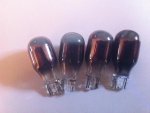1793
Senior Member
- Location
- Louisville, Kentucky
- Occupation
- Inspector
I could use a little help. I went to a customer?s today to look into his LV Landscape Lighting. These lights were installed mid February of this year. There are 9 18W, 12V Malibu Tulip style walkway lights, 6 35W Malibu Well lights. There is a 600W transformer, 2 300Ws.
There are 3 of the 18W and 3 of the 35W on one half of the transformer, the rest are on the other half.
The issue:
For the last few months there have been no problems, about a week or so ago 8 of the 9 Tulip light bulbs burned out over a two day period. 3 of the 8 new bulbs went out in about three days.
The lights are on at night for about 9 hrs. The bulb package states that the bulbs should last ? year based on 3 hrs of burn each day. By my calculations, with the amount of time these are on each night they should last about 2 months, this sounds right for the original bulbs, what I can?t see is why the replacements are burning out so quickly.
Any ideas why this is starting to happen?
Here is a photo of a few of the old bulbs.

There are 3 of the 18W and 3 of the 35W on one half of the transformer, the rest are on the other half.
The issue:
For the last few months there have been no problems, about a week or so ago 8 of the 9 Tulip light bulbs burned out over a two day period. 3 of the 8 new bulbs went out in about three days.
The lights are on at night for about 9 hrs. The bulb package states that the bulbs should last ? year based on 3 hrs of burn each day. By my calculations, with the amount of time these are on each night they should last about 2 months, this sounds right for the original bulbs, what I can?t see is why the replacements are burning out so quickly.
Any ideas why this is starting to happen?
Here is a photo of a few of the old bulbs.



